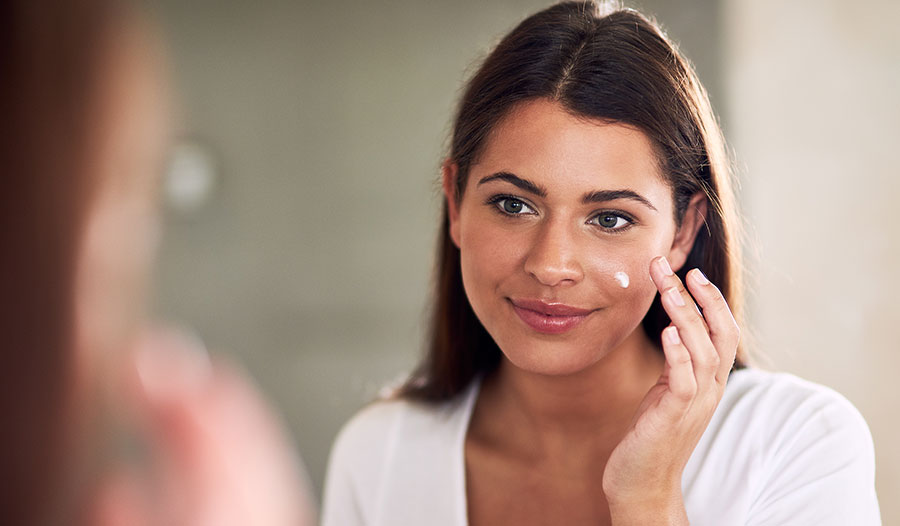Should I Be Using Probiotics In My Skincare?
DISCLAIMER:This blog does not intend to provide diagnosis...
- In this article:
- What Are Probiotics and Prebiotics–and Why Are We Talking About Them?
- What Are the Roles of Probiotics and Prebiotics in Skincare?
- What Are Some Products Containing Probiotics or Prebiotics?
- Do Probiotics In Skincare Products Work?

Keeping up with beauty trends is no easy task, and deciphering skincare facts from fiction can be especially daunting for consumers. That’s where I come in as a dermatologist–it’s my job to practice evidence-based medicine, whether treating psoriasis or helping address a patient’s beauty and skincare concerns.
Today I’ll be reviewing one of the hottest new trends in skincare–topical probiotics –but before you run out to buy a tub of Greek yogurt to slather on your face in the name of the latest beauty movement, allow me to break down what we currently know about the role of probiotics in skincare and highlight some key products you can use to remedy some common skin concerns.
What Are Probiotics and Prebiotics–and Why Are We Talking About Them?
Let’s start with some basics. We’ve all heard of probiotics, but what are they exactly, and how do they differ from prebiotics? We should begin first with the following concept: our bodies are inhabited by various microorganisms, including bacteria, yeasts, and viruses. The composition of and interplay between these organisms is termed the microbiome. It is integral in maintaining homeostasis, or balance, in our bodies, particularly when it comes to the immune system. An imbalance between good and harmful bacteria, for example, has the potential to lead to disease states.
Probiotics are live microorganisms (bacteria) that, when ingested in appropriate amounts in foods and supplements, serve to provide health benefits. Examples of familiar foods that naturally contain these “good” bacteria include yogurt, kimchi, sauerkraut, kefir, and kombucha. Prebiotics are essentially fiber-rich substances we get from our diet (think: fruits, vegetables, legumes) that we as humans cannot digest, but that feed our good gut bacteria. The use of probiotics in medicine came from the idea that promoting the growth of good bacteria would help to maintain homeostasis in the face of genetic and day-to-day environmental factors that have the potential to disrupt this balance.
What Are the Roles of Probiotics and Prebiotics in Skincare?
Studies have demonstrated that the intestinal microbiome plays a role in modulating inflammation not just in the gut, but in the skin as well! In the realm of dermatology and skincare, overgrowth of certain bacteria and yeast have been implicated in acne, rosacea, psoriasis, dandruff, and more–not to mention the role bacteria play in causing infections, particularly in those with underlying conditions such as eczema that leads to a dry, damaged skin barrier. Enthusiasm for the use of oral probiotics and prebiotics for the promotion of a healthy gut microbiome has been buzzing for quite some time, but there has been increasing interest in the use of topical probiotics and prebiotics with the hope that this, too, will lead to skin health benefits by way of promoting the growth of good bacteria that live on our skin.
Probiotics have been shown in some studies to play a role in combating signs of skin aging by helping to restore acidic skin pH, relieve oxidative stress, improve skin barrier function, and diminish the effects of photoaging (think wrinkles, sunspots, and skin laxity) by protecting against UVB-induced sun damage. One study, in particular, noted a significant improvement in wrinkle depth severity and hyperpigmentation in study participants receiving high topical concentrations of the probiotic formula!
Sidebar: it is here where I must fight the urge not to stray off-topic to preach the benefits of sunscreen and sun-protective clothing (because prevention of UV radiation-induced damage in the first place will always be steps #1, #2, and #3 in my book). That being said, while we do not have nearly the robust body of evidence behind probiotics that we do for sunscreen, it is not surprising that these promising early anti-aging results have led to a rapid surge in the popularity of topical probiotics.
What Are Some Products Containing Probiotics or Prebiotics?
You’re probably thinking, great, now I know what prebiotics and probiotics are, but what products are actually out there and how can I incorporate them into my skincare regimen? Lucky for you, because of their recent boom in popularity, there are a number of products to select from depending on your specific skincare needs and concerns. Below are a few of my picks:
Moisturizers
A good moisturizer is an absolute staple in every skincare regimen. Moisturizers help to retain your skin’s moisture (intuitive, I know) and also help to improve certain signs of aging (dryness, dullness, fine lines). Here is a probiotic-containing moisturizers to consider adding to your rotation: Hero Cosmetics Clear Collective Clarifying Prebiotic Moisturizer.
Skin Brightening
Skincare brands are becoming increasingly savvy, recognizing that consumers want to find formulations with the most bang for their hard-earned buck. More and more products are combining smart ingredients such as vitamin C and niacinamide antioxidants in one powerful product address to multiple skin concerns. Want a moisturizer containing probiotics that also boasts additional skin brightening properties to increase radiance and combat dullness? Look no further:
Derma E Vitamin C Renewing Moisturizer with Probiotics and Rooibos - Reap the benefits of the addition of Vitamin C, here formulated in a stable, gentle form—sodium ascorbyl phosphate. Other benefits include being 100% vegan and cruelty-free.
Derma E Vitamin C Intense Night Cream - Similarly to their Vitamin C Renewing Moisturizer, Derma E’s Vitamin C Intense Night Cream boasts a sodium ascorbyl phosphate, 100% vegan, and cruelty-free formulation best suited to nighttime use.
Andalou Naturals Renewal Cream Probiotic +C Brightening - This vegan and cruelty-free option has a pleasant citrus smell and contains vitamin C in the form of stable magnesium ascorbyl phosphate.
InstaNatural Hyaluronic Oil Free Moisturizer - For ultimate hydration and brightening, consider this cruelty-free moisturizer which contains both hyaluronic acid and vitamin C. A little bit goes a long way with this one!
Do Probiotics In Skincare Products Work?
We know a lot, but not everything, about how the skin microbiome works, and more research is needed to understand who is most likely to benefit from topical probiotics. It is safe to say this will be an active area of research for years to come and it is incredibly exciting that safe, affordable, accessible new products are continuing to hit the market to give patients and consumers a wider array of options when it comes to their unique skin.
References:
- Byrd, A., Belkaid, Y. & Segre, J. The human skin microbiome. Nat Rev Microbiol 16, 143–155 (2018). https://doi.org/10.1038/nrmicro.2017.157
- Ellis SR, Nguyen M, Vaughn AR, Notay M, Burney WA, Sandhu S, Sivamani RK. The Skin and Gut Microbiome and Its Role in Common Dermatologic Conditions. Microorganisms. 2019 Nov 11;7(11):550. doi: 10.3390/microorganisms7110550. PMID: 31717915; PMCID: PMC6920876.
- França K. Topical Probiotics in Dermatological Therapy and Skincare: A Concise Review. Dermatol Ther (Heidelb). 2021 Feb;11(1):71-77. doi: 10.1007/s13555-020-00476-7. Epub 2020 Dec 19. PMID: 33340341; PMCID: PMC7859136.
- Notay M, Saric-Bosanac S, Vaughn AR, Dhaliwal S, Trivedi M, Reiter PN, Rybak I, Li CC, Weiss LB, Ambrogio L, Burney W, Sivamani RK. The use of topical Nitrosomonas eutropha for cosmetic improvement of facial wrinkles. J Cosmet Dermatol. 2020;19(3):689–93. https://doi.org/10.1111/ jocd.13060.
- Scharschmidt, T. C. & Fischbach, M. A. What lives on our skin: ecology, genomics and therapeutic opportunities of the skin microbiome. Drug Discov. Today Dis. Mech. 10, e83–e89 (2013).
- Sharma D, Kober MM, Bowe WP. Anti-aging effects of probiotics. J Drugs Dermatol. 2016;15(1):9–12

 By Dr. Brittany Oliver, M.D., F.A.A.D.
By Dr. Brittany Oliver, M.D., F.A.A.D.


